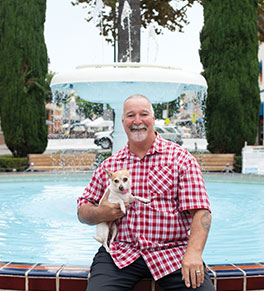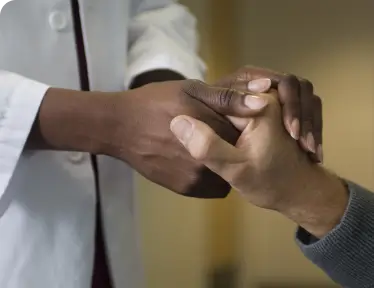Bone marrow transplant: lifesaving care close to home

“I have great hope the cancer is not going to come back,” says Dan Ferguson. “At UCI, they have done everything to make sure I’m OK and feeling good.”
Photo by Lauren Pressey
Dan Ferguson was relieved and grateful when he learned he could undergo a transplant that would likely cure him of multiple myeloma, a type of cancer that arises in bone marrow.
However, the 62-year-old flatbed truck driver was far less enthused when he realized he’d have to get treatment in Los Angeles — some 50 miles from his home in Orange. And it would require multiple outpatient visits to prepare for the transplant, several weeks in a hospital and dozens of follow-up appointments.
“I knew I had a better chance of remission with a bone marrow transplant, but I didn’t want to go to L.A. if I didn’t have to,” he says. “It’s a mess to drive there.”
The previous two years had not been kind to Ferguson. In 2017, he broke seven bones in a motorcycle crash. The diagnosis of cancer in his hip bone came in August 2019.
Then in early 2020, after he completed four months of chemotherapy and needed to make a decision further treatment, his oncologist told him that UCI Health was opening Orange County’s first adult bone marrow transplant program — and Ferguson could be its first patient.
On May 22 — what he calls “day zero of my new life” — Ferguson had the transplant of his own treated bone marrow stem cells. Months later, his physicians say he is recovering very well. He still expresses joy that he received treatment 15 minutes from his home “in a hospital with a view of Angel Stadium!”
A milestone in cancer care
At the UCI Health Chao Family Comprehensive Cancer Center, Orange County’s only National Cancer Institute-designated comprehensive cancer center, Ferguson’s case was celebrated too. The bone marrow transplant program is the first of its type in Orange County, providing patients who can benefit from stem cell transplants the convenience of receiving high-quality treatment close to home.
The Hematopoietic Stem Cell Transplant and Cellular Therapy Program also opens the way for the cancer center to deliver innovative immunotherapy options for patients with blood and other cancers.
“No one was providing this service to the people of Orange County before our program, meaning they had to travel to surrounding centers,” says Dr. Stefan O. Ciurea, professor of medicine and program director. Ciurea was recruited from the renowned MD Anderson Cancer Center in Houston to lead the program. “Orange County is a very big county with more than three million people. We needed to have a transplant center.”
The program — which uses hematopoietic cells, immature stem cells found in bone marrow and blood — also marks a milestone in the growth of blood cancers treatment, says Dr. Richard Van Etten, director of the cancer center and a professor of hematology/oncology at the UCI School of Medicine. Since 2013, the number of UCI patients being treated for blood cancers such as leukemia and lymphoma has increased dramatically.
“But many of our patients need stem cell transplants as part of their treatment,” he says. “We’ve had to refer them to programs in Los Angeles. The problem is that it causes delays. Apart from the distance, there are a lot of logistical issues to get the referral set up, and insurance questions take time to resolve. Many patients don’t have that time. The stem cell transplant program fits within our paradigm of trying to keep care close to home.”
A challenging treatment
Stem cell transplants are used to treat several types of cancer that arise in the blood or lymphatic systems, such as leukemia, lymphoma and multiple myeloma. But the procedure is challenging and can only be performed at high-level institutions, usually academic medical centers or National Cancer Institute-designated comprehensive cancer centers such as UCI’s.
Typically, treatment begins by administering high doses of chemotherapy to the patient, sometimes with radiation therapy to kill any remaining cancer cells and stem cells in the patient’s bone marrow. Treated stem cells are then infused after chemotherapy to replace those that have been destroyed. The transplanted cells settle in the bone marrow to make healthy new blood cells.
Patients undergo either an autologous stem cell transplant — using their own stem cells, as Ferguson did — or an allogeneic transplant using stem cells from a donor whose bone marrow has certain characteristics that match the patient’s.
“The allogeneic cells reset the patient’s immune system,” Ciurea says. “The new immune system recognizes the malignant tumor and attacks it.”
Ferguson underwent chemotherapy to reduce the amount of cancer cells in his bone marrow, then began the transplantation process at the cancer center under the supervision of UCI Health hematologic oncologist Dr. Deepa Jeyakumar, a fellowship-trained in bone marrow transplantation who helped launch the program.
After many exams and tests to ensure his safety, he had a five-hour procedure to collect his stem cells.
Day zero of a long journey
A few days later he checked into the hospital at UCI Medical Center for a 23-day stay. There he received the high-dose chemotherapy and then his refreshed bone marrow cells.
“They were confident I would be a great candidate for a bone marrow transplant, and I was excited about it,” he said. “The chemotherapy was tough. I had some side effects, such as a rash on my chest. But I kept telling myself it could be worse.”
The joyful send-off party the bone marrow transplant team gave Ferguson was a high point. However, a few days later a fever landed him back in the hospital for a five-day stay. Finally, he went home and began working to recover his strength and stamina.
Transplanting hematopoietic stem cells is challenging and requires considerable staff expertise and special facilities, Ciurea says. Four UCI physicians are trained in stem cell transplantation, as are nurse specialists, pharmacists and support personnel. Next year, UCI Health expects to complete construction of a facility on the Irvine campus to process cellular therapies.
“By its nature, this is a very risky treatment,” he explains. “There are many components. We have to collect the stems cells and store them in a cell therapy lab. You also need a specialized lab to process these cells.”
Moreover, the patients are highly immunocompromised, Van Etten says. Treatment typically requires a four- to six-week hospitalization in isolation to keep them alive and responding to the transplanted cells.
“When they leave the hospital, they are very fragile and need to be seen three times a week by the transplant team, more frequently if there is an emergency,” Ciurea says. “It is a logistical nightmare for patients who have to travel long distances for care. That’s why we want to help patients keep their care at UCI.”
The future of cancer care: cellular therapies
In addition to hematopoietic stem cell transplants, UCI Health researches and offers other cellular treatments. Cellular therapies involve collecting a particular type of cell from the blood, re-engineering the cells to fight cancer and giving the treated cells back to the patient. Among the most prominent cancer cellular therapies is chimeric antigen receptor T cell therapy (CAR T-cell).
While only a few CAR T therapies are approved for use by the U.S. Food and Drug Administration, intense research is ongoing worldwide to expand treatment to other types of cancer, including solid tumors. The research has proven difficult. Now, UCI Health researchers are joining the fight.
“My vision — and Dr. Ciurea’s — is to do the basic research and development of these approaches in the lab and extend them into clinical practice,” Van Etten says.
Ciurea is already a leader in a type of therapy known as natural killer cell therapy. He has a decade of research experience in the field and has authored several scientific papers to advance the concept.
“This is a type of cell that is present in everyone’s blood,” he says. “It’s a component of our immune system that specializes in eliminating tumor cells. I believe this is an upcoming therapy and, I hope, the next FDA-approved cellular therapy.”
Van Etten praises the expertise Ciurea brings to UCI. “He came from the largest program in the country. He was incredibly effective there and has a wealth of clinical and translational experience. He is the perfect person to lead our program.”
Preventing relapse
Ciurea is also working on strategies to reduce the risk of relapse, which occurs in some patients following hematopoietic stem cell transplantation. “Relapse is the main cause of transplant failure,” he says, noting that outcomes have improved over the years as physicians have learned to treat infections and found better ways to match allogeneic stem cell transplant patients.
“Having a way to decrease the relapse rate is a huge step for transplantation and a huge step for cancer therapy in general because this can be applied to other areas of oncology,” Ciurea says. “For the first time since the beginning of transplantation in the 1960s, we might find a way to decrease the relapse rate.”
Ferguson has faith in his UCI Health team. “I have great hope the cancer is not going to come back,” he says. “At UCI, they have done everything to make sure I’m OK and feeling good.”
Learn more about the Hematopoietic Stem Cell Transplant and Cellular Therapy Program ›
Explore further
Browse more blog posts by topic.




